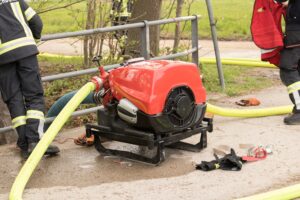
If you have experienced flooding, as many have during this rainy summer, you know that a water pump is an important part of the cleanup process, helping move gallons of water quickly and efficiently to dry out flooded basements and assist contractors on job sites.
“These pumps are powerful and can speed up a cleanup job after a flood,” said Kris Kiser, president and CEO of the”¯Outdoor Power Equipment Institute (OPEI), an international trade association representing power equipment, small engine, utility vehicle, golf car and personal transport vehicle manufacturers and suppliers. But understanding which pump to use and how to use it effectively is key to that cleanup:
”¯
Get the right pump for the water and debris you are trying to clear. There are four basic types of pumps:
Dewatering pumps suck in water through an inlet valve and eject it from a discharge valve. They have an inlet size ranging from 1 to 4 inches. A 4-inch dewatering pump will finish a job four times faster than a 1-inch pump.
A semi-trash pump is used to pump clear or slightly muddy and sandy water. You will want to use a hose with a strainer so the hose doesn”™t get clogged with items too big to pass through.
A trash pump is made to handle debris and solids, such as leaves, pebbles and twigs. These pumps have larger impellers and leave debris intact. Use a hose with a strainer for a trash pump, so items that are too large don”™t enter.
Diaphragm pumps are most commonly used to pump sludge and extremely abrasive liquids. The pump has a diaphragm that is pushed up and down, creating a vacuum effect that draws in water.
Know how to operate the pump. Review the manual and manufacturer”™s directions, following them carefully.
Follow safety procedures. Make sure all safety guards and shields are in place while operating your water pump. Never use a pump in a flammable or explosive environment. ”¯Never pump substances that your pump isn’t designed to cope with. Acids, corrosive substances and flammable materials should not be pumped with an ordinary water pump. If in doubt, refrain from pumping.
Don”™t run a gasoline-fueled engine indoors. If you must use the pump indoors, ventilate the area to the outside and seal it off from the rest of the building. Never leave any pump in a confined space where heat can build up. Keep the pump at least 3 feet away from walls and other obstructions so it can ventilate. If a pump becomes overheated, switch it off and allow it to return to a safe temperature before using it again.
Maintain a pump with inspections and proper fueling.”¯Regular inspection and maintenance will make your pump last longer. Always fuel any gasoline-powered pump with E10 or less. It is illegal to use gasoline with more than 10 percent ethanol in a small engine like your pump, and higher ethanol blended fuels may damage or destroy small engine equipment.
Store your pump safely.”¯Remember to flush the pump case with clean fresh water, then completely drain it to prevent damage from freezing. Cover the intake and discharge ports to prevent the entry of debris during storage.
For more, click here.



















